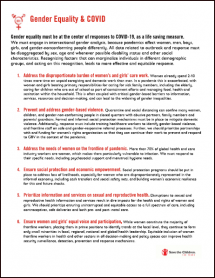COVID-19 and Gender Equality
Previous pandemics have shown that gender inequality is not a side issue and that recognizing factors that can marginalize individuals in different groups can save lives. We also know that crises exacerbate gender inequalities.
Gender equality must be at the center of responses to COVID-19, as a life saving measure. Programs must engage in intersectional gender analysis, because pandemics affect women, men, boys, girls, and gender-nonconforming people differently. All data related to outbreak and response must be disaggregated by sex, age and whenever possible disability status and other social characteristics. Recognizing factors that can marginalize individuals in different demographic groups, and acting on this recognition, leads to more effective and equitable response.
Additionally, programs must:
1. Address the disproportionate burden of women’s and girls’ care work
2. Prevent and address gender-based violence
3. Address the needs of women on the frontline of pandemic
4. Ensure social protection and economic empowerment
5. Prioritize information and services on sexual and reproductive healthEnsure women and girls’ equal voice and participation
Last modified: July 21, 2020
Language: English

